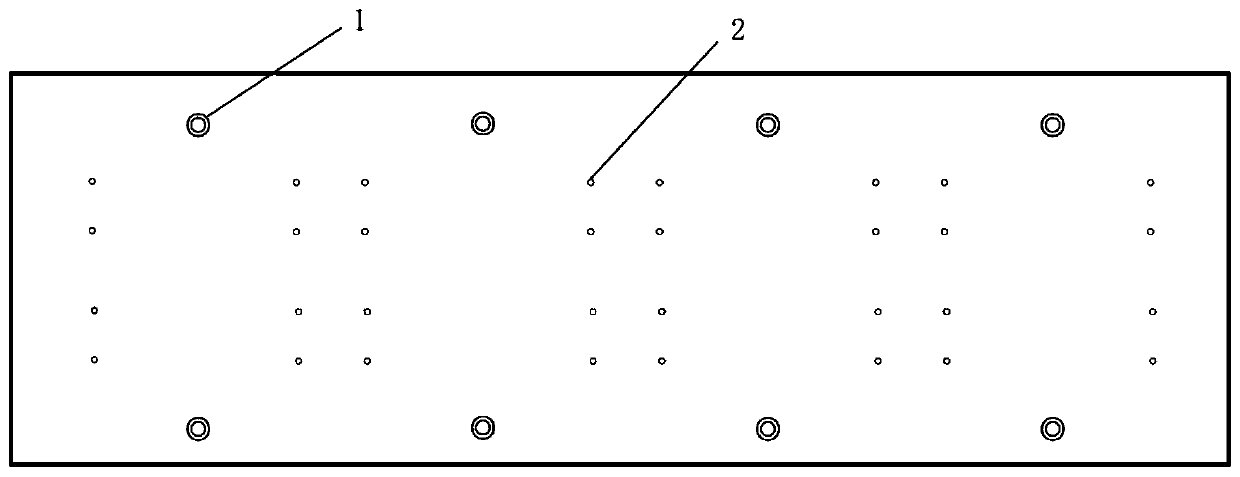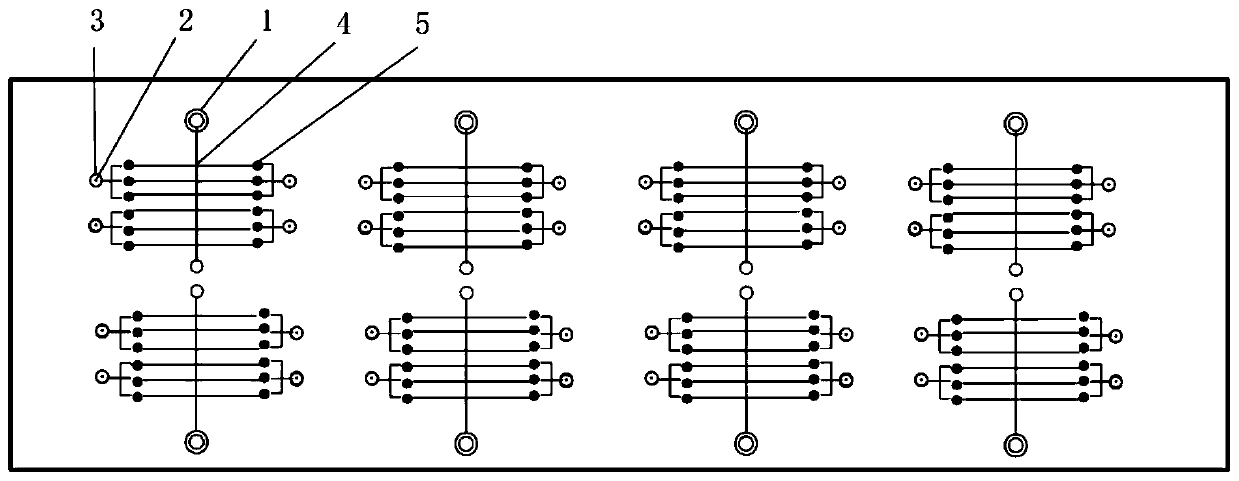Self-driven microfluidic detection chip and preparation method and application thereof
A detection chip and microfluidic technology, applied in the field of microbial detection, can solve the problems of puncture, small amount of sample detection at one time, high detection cost, etc., and achieve the effect of preventing nucleic acid cross-contamination, aerosol pollution, and external pollution
- Summary
- Abstract
- Description
- Claims
- Application Information
AI Technical Summary
Problems solved by technology
Method used
Image
Examples
Embodiment 1
[0059] Such as figure 1 , 2 As shown, the self-driven microfluidic detection chip of this embodiment includes several detection units, and each detection unit includes an upper chip layer and a lower chip layer arranged in sequence:
[0060] The upper layer of the chip is provided with a sampling pool 1 and an air vent 2, and the sampling pool 1 adopts an inverted tapered design, and the sampling pool 1 and the air vent 2 all run through the upper layer of the chip; the lower layer of the chip is provided with a fluid channel 4, The detection pool 5 and the waste liquid pool 3; the fluid channel 4 is respectively connected to the waste liquid pool 3 and the detection pool 5, the upper layer of the combined chip and the lower layer of the chip, and the sampling pool 1 is connected to the detection pool 5 and the waste liquid pool through the fluid channel 4 3 connected, the waste liquid pool 3 communicates with the exhaust hole 2, and the surface of the fluid channel 4 is prov...
Embodiment 2
[0078] Step 1. Specificity analysis of target gene detection
[0079] The prawn tissues infected with WSSV, IHHNV, SHIV, AHPND, EHP, IMNV, CMNV, TSV, YHV-1 and YHV-8 preserved in the laboratory were selected as the samples to be tested, and the nucleic acid targeted release agent (volume ratio of isothiocyanate Guanidinium acid salt: polyacrylamide: BSA: gelatin = 6:2:1:1) quickly extract sample nucleic acid as a detection template, and operate according to the instruction manual.
[0080] Take the self-driven microfluidic chip prepared in Example 1, add 6 groups of sample detection units in sequence: DNA containing equal proportions of infected WSSV, IHHNV, SHIV, AHPND, EHP shrimp tissues (final concentration is 10ng / μL ); containing equal proportions of RNA infected with IMNV, CMNV, TSV, YHV-1, and YHV-8 shrimp tissues (final concentration: 10 ng / μL); all repeated 3 times. Take SPF Litopenaeus vannamei tissue nucleic acid (final concentration 10ng / μL) and add it to the nega...
Embodiment 3
[0087] Step 1. Extraction of sample nucleic acid:
[0088] 1) The Marine Aquaculture Biological Disease Control and Molecular Pathology Laboratory of the Yellow Sea Fisheries Research Institute of the Chinese Academy of Fishery Sciences collected 6 samples of diseased prawns from different regions across the country, and the prawn tissues were cut into 0.5×0.5cm 2 Tissue pieces of different sizes were put into correspondingly numbered 1.5mL EP tubes and kept on ice. Add 150 μL of water to the sample tube, immerse the tissue sample, homogenize for 1-3 minutes, until no tissue remains, and let stand at room temperature for 5 minutes.
[0089] 2) Prepare nucleic acid targeted release agent, the volume ratio is guanidinium isothiocyanate:polyacrylamide:BSA:gelatin=6:2:1:1.
[0090] Add 5 μL nucleic acid targeted release agent to a 0.2mL PCR tube, add 20 μL of the above-mentioned tissue grinding supernatant and mix well; place in a metal bath, keep warm at 99°C for 10 minutes; tak...
PUM
| Property | Measurement | Unit |
|---|---|---|
| thickness | aaaaa | aaaaa |
| diameter | aaaaa | aaaaa |
| depth | aaaaa | aaaaa |
Abstract
Description
Claims
Application Information
 Login to View More
Login to View More - R&D
- Intellectual Property
- Life Sciences
- Materials
- Tech Scout
- Unparalleled Data Quality
- Higher Quality Content
- 60% Fewer Hallucinations
Browse by: Latest US Patents, China's latest patents, Technical Efficacy Thesaurus, Application Domain, Technology Topic, Popular Technical Reports.
© 2025 PatSnap. All rights reserved.Legal|Privacy policy|Modern Slavery Act Transparency Statement|Sitemap|About US| Contact US: help@patsnap.com



